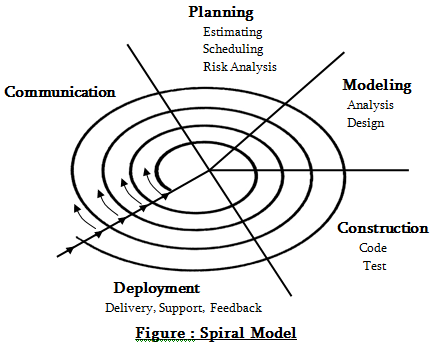Spiral Model:
The spiral model is an evolutionary software process model that combines the iterative nature of prototyping with the controlled and systematic aspects of the linear sequential model. Using the spiral model, software is developed in a series of incremental releases. During early iterations, the incremental release might be a paper model or prototype. During later iterations, increasingly more complete versions of the engineered system are produced.
A spiral model is divided into a number of framework activities, also called task regions. Typically, there are between three and six task regions. Given figure is of a spiral model that contains five task regions.
1. Customer communication
Tasks required to establish effective communication between developer and customer.
2. Planning
Tasks required to define resources, timelines, and other project related information.
3. Modeling
Tasks required in building one or more representations of the application.
4. Construction and release
Tasks required to construct, test, install.
5. Deployment
Tasks required to deliver the software, getting feedbacks etc.
Software engineering team moves around the spiral in a clockwise direction, beginning at the center. The first circuit around the spiral might result in the development of a product specification; subsequent passes around the spiral might be used to develop a prototype and then progressively more sophisticated versions of the software. Each pass through the planning region results in adjustments to the project plan. Cost and schedule are adjusted based on feedback derived from customer evaluation. In addition, the project manager adjusts the planned number of iterations required to complete the software.
The spiral model is a realistic approach to the development of large-scale systems and software. The spiral model enables the developer to apply the prototyping approach at any stage in the evolution of the product. The spiral model demands a direct consideration of technical risks at all stages of the project and, if properly applied, should reduce risks before they become problematic. It demands considerable risk assessment expertise and relies on this expertise for success.
